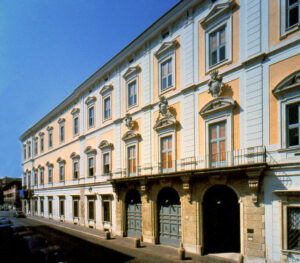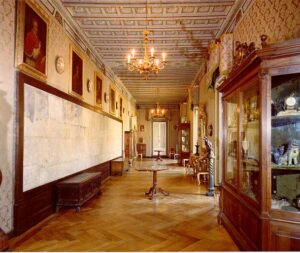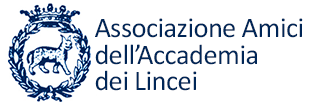The Association has its headquarters in Palazzo Corsini, on the premises of the Accademia Nazionale dei Lincei.
Palazzo Corsini
 The headquarters of the Accademia Nazionale dei Lincei is Palazzo Corsini, at Via della Lungara, 10, in Rome’s Trastevere district. The Farnesina complex across the street (house no. 230) serves as its representative seat.
The headquarters of the Accademia Nazionale dei Lincei is Palazzo Corsini, at Via della Lungara, 10, in Rome’s Trastevere district. The Farnesina complex across the street (house no. 230) serves as its representative seat.
In 1736, Cardinal Neri Corsini Junior, member of a noble Florentine family and nephew of Lorenzo Corsini, Pope Clement XII, purchased Palazzo Riario, where Michelangelo had stayed as a young man and which had later been the residence of Queen Christina of Sweden (there is a commemorative plaque in a room on the first floor). He commissioned the Florentine architect Ferdinando Fuga to entirely modify and enlarge the building, which, known as Palazzo Corsini, is one of the most splendid Roman palaces of the 18th century. In 1883, only 13 years after the seizure of Rome, the palace was purchased for 2.4 million lira by the Italian Government to house the offices and library of the Royal Academy of the Lincei and the Gallery of Ancient Art, formerly Corsini. The Corsinis returned to Florence. Prince Tommaso Corsini, in the same year, had donated his family’s beautiful library to the Academy.
He also donated a valuable and copious collection of prints to the Academy, which, together with the collection later acquired by the Ministry of Education, forms the nucleus of the National Institute of Graphics. At first it was located on the second floor of Palazzo Corsini but was later moved to the Villa della Farnesina. Finally, Tommaso Corsini also donated to the Italian State a collection of paintings, which had been started in the 18th century by Cardinal Neri and for which some rooms had been arranged on the “piano nobile” where it still is. This collection formed the first nucleus of the National Gallery of Ancient Art, which is now divided between Palazzo Barberini and Palazzo Corsini itself.

Palazzo Corsini – Exterior view
The façade on Via della Lungara is uniform and somewhat monotonous, but upon entering, one finds oneself in a beautiful scenic atrium the play of pillars that form the backdrop of a scenery is noteworthy. The rear façade of the palace appears more animated than the front, and part of the old Palazzo Riario is still visible in the building to the right. The garden, enclosed by gates decorated with vases, was much larger in ancient times and the park occupied the entire Janiculum Hill (where the Botanical Garden is now located) and beyond. From the atrium, one ascends to the first floor by means of a grand staircase with two flights of stairs of scenic effect, which is brightened by the three large windows towards the garden from which one enjoys a beautiful view of the Janiculum Hill.
The large vestibule of the first floor is shared with the upper floor, thanks to the original balcony adorned with a beautiful wrought-iron railing. The ceiling is coffered. The second floor is made up of a series of magnificent rooms, formerly the private flat of the Corsini family; the Academy’s activities currently take place in these rooms; here the meetings of the Members of the two Classes take place, numerous international and national congresses are held and Commissions meet. From the Entrance you can see the ‘Sala dei Divani’ and the ‘Sala Impero’ Worthy of note are the restored and almost entirely refurbished “Hall of Moral Sciences” and the “Hall of Physical Sciences”, which originally did not exist, as it was carved out of the upper part of the Royal Hall on the first floor. Through the windows of these two rooms one can enjoy a view of the Villa and the Farnesina garden.

Dutuit Hall
Next is the Sala dell’Alcova, the Sala Verde or Sala degli Arazzi, with a series of painted tapestries depicting episodes from Gerusalemme Liberata, the Sala Rossa, the Sala Gialla, the Sala dell’Orologio, the Sala della Segreteria, the Sala della Cancelleria and finally the Sala della Presidenza with a splendid terrace overlooking the Corsini Garden, the Botanical Garden and the Janiculum Hill. Worthy of mention, among the other rooms, is the Dutuit Room, which contains furniture and other objects that constitute the legacy of Signora Teresa Celli, widow Dutuit. Along one wall of this room is a cast of a large inscription in Greek (Doric) language from the late 6th – early 5th century BC. B.C., containing the ‘Laws of Gortina’ (Crete), discovered by an Italian archaeological mission under the direction of Member Federico Halbherr in 1884-87: they deal with family law.
